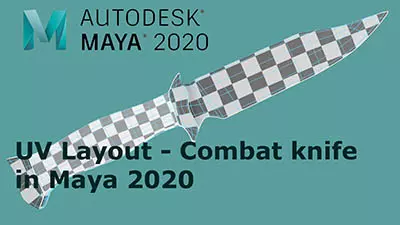Introduction to Maya - Modeling Fundamentals Vol 1
This course will look at the fundamentals of modeling in Maya with an emphasis on creating good topology. We'll look at what makes a good model in Maya and why objects are modeled in the way they are.
#
1
17-01-2008
, 08:56 AM
orbiting expression
Anyways, I was wondering how I would make an object orbit another object, and how I would get it to maintain a constant distance if the object being orbited was moving.
Any ideas would be much appreciated!!
Chris
#
2
17-01-2008
, 08:59 AM
#
3
17-01-2008
, 10:21 AM
If you want to physically rotate it then a bit of maths is needed for figuring the location in space and moving it accordingly.
I was playing about with papervision3D early last year and wrote a little flash script to rotate a moon around a planet in 3D space. If I can find it I'll post it up as an example that could be used as a 'principle of doing it' sample that could be modified for maya.
As a final thought just have a good search for maya related versions as it might be fairly simple to get the effect working with dynamics.
Good luck

Simon
Examples of bTraffic - a traffic animation tool for Maya
bFlocking - a tool for Maya 8.5+ to generate flocking and swarming behaviours
Jan/Feb Challenge 2007 Entry and W.I.P
May/Jun Challenge 2006 Entry and W.I.P
Mar/Apr Challenge 2006 Entry and W.I.P
Jan/Feb Challenge 2006 Entry and W.I.P
Nov/Dec Challenge 2005 Entry and W.I.P
Sep/Oct Challenge 2005 Entry and W.I.P
Jul/Aug Challenge 2005 Entry
www.flash-fx.net
#
4
17-01-2008
, 02:44 PM
Code:
class org.papervision3d.samples.orbit.orbit_test extends MovieClip
{
// _______________________________________________________________________
// vars3D
var container :MovieClip;
var scene :Scene3D;
var camera :FreeCamera3D;
var sphere :Ase;
// _______________________________________________________________________
// Main
function orbit_test()
{
init3D();
this.onEnterFrame = loop3D;
}
// _______________________________________________________________________
// Init3D
function init3D()
{
// Create container movieclip and center it
container = this.createEmptyMovieClip( "container", this.getNextHighestDepth() );
container._x = 320;
container._y = 240;
// Create scene
scene = new Scene3D( container );
// Create camera
camera = new FreeCamera3D();
// Create material
var texture :BitmapData = BitmapData.loadBitmap( "Bitmap" );
var material :BitmapMaterial = new BitmapMaterial( texture );
material.oneSide = true; // Make it single sided
// Load sphere
sphere = new Ase( material, "world.ase", .1 );
sphere.rotationX = 0;
sphere2 = new Ase( material, "world.ase", .025 );
sphere2.rotationX = 0;
sphere2.rotationZ = 45;
// set the moon to be 125 away from the planet
sphere2.x = sphere.x + 125;
sphere2.y = sphere.y + 125;
sphere2.radians = 0.785
sphere2.degrees = 45;
sphere3 = new Ase( material, "world.ase", .025 );
sphere3.x = sphere.x + 125;
sphere3.y = sphere.y + 125;
sphere3.z = sphere.y + 125;
sphere3.radiansX = -2;
sphere3.radiansY = 0;
sphere3.radiansZ = 0;
sphere4 = new Ase( material, "world.ase", .025 );
sphere4.x = sphere.x + 0;
sphere4.y = sphere.y + 176;
sphere4.radians = 0
sphere4.degrees = 0;
// Include in scene
scene.push( sphere );
//scene.push( sphere2 );
scene.push( sphere3 );
//scene.push( sphere4 );
}
// _______________________________________________________________________
// Loop
function loop3D()
{
// calculate the distance between the two (based on the origin being the planet at 0,0,0
dist = Math.sqrt((sphere2.x * sphere2.x) + (sphere2.y * sphere2.y));
_root.distance.text = dist;
// calculate distance between two (z axis ball)
distz = Math.sqrt((sphere3.x * sphere3.x) + (sphere3.y * sphere3.y));
angle = sphere2.radians;
sx_pos = Math.sin(angle) * dist;
sy_pos = Math.cos(angle) * dist;
sphere2.x = sx_pos;
sphere2.y = sy_pos;
sphere2.radians += 0.01;
sphere2.radians += 0.01;
sphere2.radians += 0.01;
// combined
anglex = sphere3.radiansX;
angley = sphere3.radiansY;
anglez = sphere3.radiansZ;
sx_pos = Math.sin(anglex) * dist;
sy_pos = Math.cos(anglex) * dist;
cx_pos = Math.sin(anglez) * dist
cz_pos = Math.cos(anglez) * dist
vy_pos = Math.sin(angley) * dist
vz_pos = Math.cos(angley) * dist
sphere3.x = sx_pos;
sphere3.z = cz_pos;
sphere3.y = vy_pos;
sphere3.radiansX -= 0.03;
sphere3.radiansY += 0.03;
sphere3.radiansZ += 0.03;
sphere3.rotationY = sphere3.rotationY + 0.2;
//sphere.rotationX = sphere.rotationX; //container._ymouse /3;
sphere.rotationY = sphere.rotationY + 0.4;
// Render
scene.renderCamera( camera );
}
function toRadians(degree:Number):Number {
return degree / 180 * Math.PI;
}
function toDegrees(radian:Number):Number {
return radian * 180 /Math.PI;
}
}
https://www.flash-fx.net/3D/masters/i...on3D/orbit.swf
Simon
Examples of bTraffic - a traffic animation tool for Maya
bFlocking - a tool for Maya 8.5+ to generate flocking and swarming behaviours
Jan/Feb Challenge 2007 Entry and W.I.P
May/Jun Challenge 2006 Entry and W.I.P
Mar/Apr Challenge 2006 Entry and W.I.P
Jan/Feb Challenge 2006 Entry and W.I.P
Nov/Dec Challenge 2005 Entry and W.I.P
Sep/Oct Challenge 2005 Entry and W.I.P
Jul/Aug Challenge 2005 Entry
www.flash-fx.net
Last edited by t1ck135; 17-01-2008 at 02:49 PM.
Posting Rules Forum Rules
Similar Threads
Expression on Bend Deformer Problem
by Calvin in forum Programming replies 0 on 22-08-2016
:help: Problem with varying refractive index using Expression Editor
by EonStrife in forum Lighting & Rendering replies 4 on 15-12-2011
rotation expression troubles
by bendingiscool in forum Programming replies 1 on 26-10-2007
important question with expression editor
by Jay_R_Locke in forum Maya Basics & Newbie Lounge replies 1 on 28-11-2003
Need help troubleshooting expression.
by NitroLiq in forum Programming replies 4 on 08-01-2003
Topics
Free Courses
Full Courses
VFX News
How computer animation was used 30 years ago to make a Roger Rabbit short
On 2022-07-18 14:30:13
Sneak peek at Houdini 19.5
On 2022-07-18 14:17:59
VFX Breakdown The Man Who Fell To Earth
On 2022-07-15 13:14:36
Resident Evil - Teaser Trailer
On 2022-05-13 13:52:25
New cloud modeling nodes for Bifrost
On 2022-05-02 20:24:13
MPC Showreel 2022
On 2022-04-13 16:02:13









